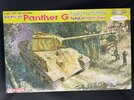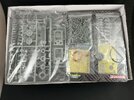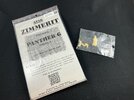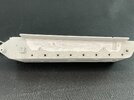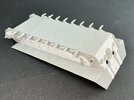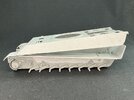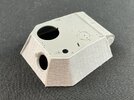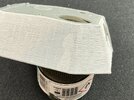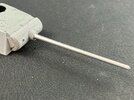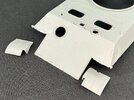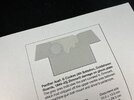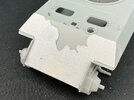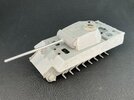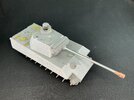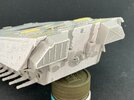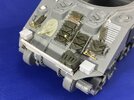Jakko
Well-Known Member
- Joined
- Oct 9, 2024
- Messages
- 676
With the models I want to finish before starting something new mostly done, I think I can safely start a thread about my next model 
This will be a Panzerkampfwagen Panther Ausführung G of 6 Guards Tank Brigade — the specific tank better known as Cuckoo. Yes, a British Panther Here's a column of Churchills:
Here's a column of Churchills:
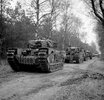
At the very back is an odd tank for a unit equipped with Churchills. Here it is as it came nearer the photographer:
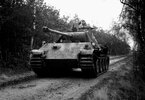
Obviously a Panther Ausf. G with Zimmerit, and clearly not in German colours, with Allied stars and British tankers crewing it.
The history of this tank is pretty interesting. Using captured enemy equipment is not an extraordinary thing in war, but the Allies generally had little need to use German armoured vehicles because they usually had plenty of their own. In early October of 1944, 6 Guards Tank Brigade was in the southeast of the Netherlands, and during the fighting around the village of Overloon (where there is now a large museum), discovered an abandoned Panther that belonged to Abteilung 2107 of Panzerbrigade 107. Because it was in running order, it was incorporated into the brigade staff. Going by photos, it was repainted in (presumably) British SCC 15 olive drab, with large Allied stars on it and the name Cuckoo painted on the turret sides. This name probably refers to it being a vehicle in the wrong nest, so to speak, but also fits with the naming of HQ vehicles in 6 Guards Tank Brigade, which all had bird names.
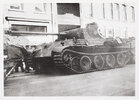
This photo was taken in the Dutch city of Tilburg (at approximately the marked location on this map, though the street pattern changed drastically since the war), which is not too far from where the tank was found, and nicely shows the name. It also shows a good deal of damage to the side skirt mounting rail. The other side was a bit more intact:
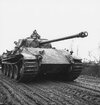
Cuckoo was first deployed in an attack on Geijsteren Castle, near where it was captured:
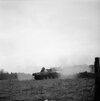
Apparently, it was valued highly by its new owners because its 75 mm gun proved much more accurate than the 95 mm howitzers of the Churchills that also took part in shelling the castle.
Cuckoo remained in use until the Battle of the Reichswald in February 1945, when the fuel pump failed somewhere east of Kleve, and because no spares were available, the tank had to be abandoned once more. This picture was taken in the town itself:
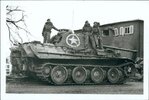
And here is film shot of the tank, in winter camouflage, which dates it to January of 1945 because it's known the tank was painted this way for Operation Blackcock in that month:
This will be a Panzerkampfwagen Panther Ausführung G of 6 Guards Tank Brigade — the specific tank better known as Cuckoo. Yes, a British Panther

At the very back is an odd tank for a unit equipped with Churchills. Here it is as it came nearer the photographer:

Obviously a Panther Ausf. G with Zimmerit, and clearly not in German colours, with Allied stars and British tankers crewing it.
The history of this tank is pretty interesting. Using captured enemy equipment is not an extraordinary thing in war, but the Allies generally had little need to use German armoured vehicles because they usually had plenty of their own. In early October of 1944, 6 Guards Tank Brigade was in the southeast of the Netherlands, and during the fighting around the village of Overloon (where there is now a large museum), discovered an abandoned Panther that belonged to Abteilung 2107 of Panzerbrigade 107. Because it was in running order, it was incorporated into the brigade staff. Going by photos, it was repainted in (presumably) British SCC 15 olive drab, with large Allied stars on it and the name Cuckoo painted on the turret sides. This name probably refers to it being a vehicle in the wrong nest, so to speak, but also fits with the naming of HQ vehicles in 6 Guards Tank Brigade, which all had bird names.

This photo was taken in the Dutch city of Tilburg (at approximately the marked location on this map, though the street pattern changed drastically since the war), which is not too far from where the tank was found, and nicely shows the name. It also shows a good deal of damage to the side skirt mounting rail. The other side was a bit more intact:

Cuckoo was first deployed in an attack on Geijsteren Castle, near where it was captured:

Apparently, it was valued highly by its new owners because its 75 mm gun proved much more accurate than the 95 mm howitzers of the Churchills that also took part in shelling the castle.
Cuckoo remained in use until the Battle of the Reichswald in February 1945, when the fuel pump failed somewhere east of Kleve, and because no spares were available, the tank had to be abandoned once more. This picture was taken in the town itself:

And here is film shot of the tank, in winter camouflage, which dates it to January of 1945 because it's known the tank was painted this way for Operation Blackcock in that month:

